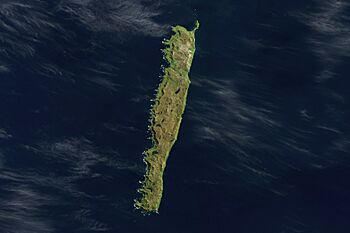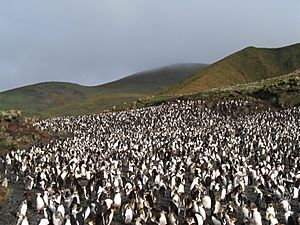Macquarie Island facts for kids
|
Nickname: Macca
|
|
|---|---|

Satellite photo of Macquarie Island
|
|
|
Location in the Southwestern Pacific Ocean
|
|
| Geography | |
| Location | Southwestern Pacific Ocean |
| Coordinates | 54°38′S 158°52′E / 54.63°S 158.86°E |
| Area | 128 km2 (49 sq mi) |
| Length | 35 km (21.7 mi) |
| Width | 5 km (3.1 mi) |
| Highest elevation | 410 m (1,350 ft) |
| Highest point |
|
| Administration | |
| State | Tasmania |
| LGA | Huon Valley Council |
| Demographics | |
| Population | No permanent inhabitants |
| Additional information | |
| Time zone | |
| UNESCO World Heritage Site | |
| Criteria | Natural: vii, viii |
| Inscription | 1997 (21st Session) |
Macquarie Island is an island in the Pacific Ocean. It lies about halfway between New Zealand and Antarctica.
Macquarie Island is about 34 km (21 mi) long and 5 km (3 mi) wide. It was first discovered in July 1810, by Captain Hasselburgh, who was searching for places to hunt whales and seals. No people live there now. The only way to get to the island is by sea and there are no harbors to dock a ship.
Contents
History
Frederick Hasselborough, an Australian, discovered the uninhabited island on 11 July 1810, while looking for new sealing grounds. He claimed Macquarie Island for Britain and annexed it to the colony of New South Wales in 1810.
Between 1810 and 1919, seals and then penguins were hunted for their oil almost to the point of extinction.
Macquarie Island was made a constituent part of Tasmania on 17 June 1880.
Between 1902 and 1920, the Tasmanian Government leased the island to Joseph Hatch (1837–1928) for his oil industry based on harvesting penguins.
Between 1911 and 1914, the island became a base for the Australasian Antarctic Expedition under Sir Douglas Mawson. George Ainsworth operated a meteorological station between 1911 and 1913, followed by Harold Power from 1913 to 1914, and by Arthur Tulloch from 1914 until the station was shut down in 1915.
In 1933, the authorities declared the island a wildlife sanctuary under the Tasmanian Animals and Birds Protection Act 1928 and, in 1972, it was made a State Reserve under the Tasmanian National Parks and Wildlife Act 1970. On 25 May 1948, the Australian National Antarctic Research Expeditions (ANARE) established its expedition headquarters on Macquarie Island. In March 1949, they were visited by the Fifth French Antarctic Expedition on their return trip from Adélie Land where any landing was made impossible due to extensive pack ice that year.
On 23 December 2004, an earthquake measuring 8.1 on the moment magnitude scale rocked the island but caused no significant damage.
Geography
The island consists of plateaus at north and south ends. The high points include Mount Elder on the north-east coastal ridge at 385 m (1,263 ft), and Mounts Hamilton and Fletcher in the south at 410 m (1,345 ft).
Near Macquarie Island are two small groups of minor islands: the Judge and Clerk Islets (54°21′S 159°01′E / 54.350°S 159.017°E), 14 km (9 mi) to the north, 0.2 km2 (49 acres) in area, and the Bishop and Clerk Islets (55°03′S 158°46′E / 55.050°S 158.767°E), 34 km (21 mi) to the south, 0.6 km2 (150 acres) in area.
Geology
The island was formed by two tectonic plates meeting and forcing each other upwards. It is the only place on Earth where rocks from the Earth's mantle, 6 km (4 mi) below the ocean floor, are being pushed up above sea level.
Climate
Macquarie Island has a Tundra climate. It often snows there from June to October.
The temperature on the island is usually around 4.9°C (40.8°F) in July and can go up to 8.8°C (47.8°F) in January. It rains a lot throughout the year, with about 1,002.1 mm (39.5 inches) of rain each year.
The island has rain on about 317 days each year, and it snows on around 56 days.
Plants and animals
Many birds and animals use Macquarie Island to breed. About 3.5 million seabirds come to the island every year. Four types of penguins live on the island. There are about 850,000 royal penguins, 200,000 king penguins, 10,000 gentoo penguins, and rockhopper penguins with numbers thought to be between 20,000 and 1,000,000.
Mammals found on the island include subantarctic fur seals, Antarctic fur seals, New Zealand fur seals and 80,000 southern elephant seals.
In 1977 Macquarie Island became a Biosphere Reserve. The coastal ecosystem is recognized as part of UNESCO's Man and the Biosphere (MAB) Programme.
Current threats
The arrival of Europeans in 1810 changed the island's wildlife a lot. With travelers came rats and mice, who began to thrive due to lack of predators. To prevent rodents from eating human food supplies, people brought cats to the island.
In about 1870, rabbits and a species of New Zealand rail (wekas) were left on the island by sealers to breed for food. This caused huge damage to the local wildlife, including the extinction of the Macquarie Island rail (Gallirallus macquariensis), the Macquarie parakeet (Cyanoramphus erythrotis), and an as-yet-undescribed species of teal. By the 1970s, there were about 130,000 rabbits on the island, and they were damaging the plants.
The feral cats had a devastating effect on the native seabird population, with an estimated annual loss of 60,000 seabirds. To help the seabirds, people started removing the cats in 1985. By June 2000, almost all of the 2,500 cats were gone. The seabird population began to recover, but then the number of rats and rabbits increased, causing more damage to the environment. The rats and rabbits were eating young birds and damaging the grass, which led to soil erosion and landslides. In September 2006, a big landslide destroyed part of a penguin breeding area.
In 2007, the Australian and Tasmanian governments announced a plan to get rid of the rats and rabbits to protect Macquarie Island. They planned to use bait to help eliminate the pests, but this caused some unintended harm to other birds, so the program was paused.
By February 2012, reports said that rabbits, rats, and mice were almost all gone from the island. By April 2012, only a few rabbits were found, and by July 2013, there were no signs of rabbits at all.
On April 8, 2014, Macquarie Island was officially declared pest-free after seven years of hard work. This was the biggest successful pest removal project ever attempted on an island. As of May 2024, the island has stayed pest-free for 10 years, and the plants are thriving. However, scientists continue to monitor the island to protect it from new threats like climate change and bird diseases.
Interesting facts about Macquarie Island
- The island was named for Colonel Lachlan Macquarie, Governor of New South Wales from 1810 to 1821.
- The Russian explorer Fabian Gottlieb von Bellingshausen explored the area for Alexander I of Russia in 1820, and produced the first map of Macquarie Island.
- Macquarie Island is one of the cloudiest places in the world. On average, it gets 289 cloudy days a year.
- Although Macquarie Island is now pest-free, several invasive bird species, such as the Domestic mallard and European starling, are found there.
- In the 19th century a phantom island named "Emerald Island" was believed to lie south of Macquarie Island.
- The island became a UNESCO World Heritage Site in 1992.
Related pages
Images for kids
-
Simplified geological map
-
Macquarie Island flora, Epilobium pedunculare
-
Macquarie Island flora, Stilbocarpa polaris
-
Bull elephant seal fighting
-
King penguin Lusitania Bay
-
Highland herbfield dominated by Pleurophyllum hookeri
See also
 In Spanish: Isla Macquarie para niños
In Spanish: Isla Macquarie para niños




















